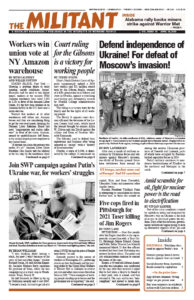April 21, 1997
Millions of Russian workers participated in a nationwide strike March 27 to protest sharply declining economic conditions. It was the largest strike against the government since the collapse of the Soviet Union in 1991. Nearly 100,000 people gathered in the streets of Moscow and St. Petersburg, and there were protests in more than 1,200 other cities.
Mikhail Shmakov, a trade union official, asserted that 20 million joined the protest for back payment of wages and pensions. Millions of workers have gone unpaid for months. “Our patience has blown up,” declared Ivan Ivanov, a retired shipyard worker who hasn’t received his pension in three months.
Economic conditions continue to deteriorate. This is reflected in the birth rate, which dropped from 17 births per 1,000 residents in 1985 to just nine per 1,000 in 1996.
April 21, 1972
APRIL 12 — Thirty-nine war ships and more than 600 planes are alerted for war duty or are en route to Southeast Asia in addition to the U.S. task force already mobilized in the war zone. This will double the naval and bomber strength President Nixon is bringing to bear against the two-week-old revolutionary offensive in South Vietnam.
It is evident that the administration hopes to lay waste the cities and countryside of Vietnam in retaliation for the revolutionary offensive. This armada will be capable of launching by far the biggest air attack — accompanied by off-shore shelling — in the history of the war.
The eyes of the ruling class will be trained on April 22, the date of the antiwar demonstrations set for New York and Los Angeles. Nixon must be answered with the biggest voice ever: “Stop the Bombing!” “Out Now!”
April 19, 1947
EXETER, Pa., April 11 — An explosion yesterday snuffed out the lives of nine miners and injured nine others. This explosion came 17 days after the Centralia disaster which cost 111 lives. This is the year’s second major disaster for this area — an explosion in nearby Plymouth claimed 15 victims on Jan. 15.
Shortly after the miners had begun work a terrific explosion ripped through the Marcy vein 350 feet below the surface. The blast wrecked doors, brattice work and side walls. All men working in the vein were either killed or injured. Rescue operations were fatally delayed as oxygen masks — needed to penetrate the gas-filled workings — were sent from other mines. There were no masks at the Exeter mine.
This mine had been inspected by Federal Inspector G.M. Mortenson last November. His inspection reported numerous safety violations.

